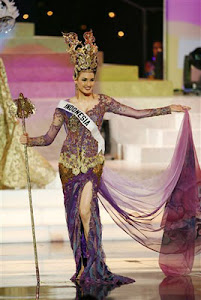 Indonesia’s most famous archaeological remains are undoubtedly the bones of “Java Man,” a humanoid ancestor from half a million years ago. Not much is known about this link in the chain of human evolution; the arrival of more modern Indonesians is much more certain. About 3000 years ago, tribes from Vietnam and southern China migrated to these tropical islands. They brought their culture and technology with them, including an Austronesian language, metal tools, rice irrigation techniques, and buffalo sacrifice rituals.
Indonesia’s most famous archaeological remains are undoubtedly the bones of “Java Man,” a humanoid ancestor from half a million years ago. Not much is known about this link in the chain of human evolution; the arrival of more modern Indonesians is much more certain. About 3000 years ago, tribes from Vietnam and southern China migrated to these tropical islands. They brought their culture and technology with them, including an Austronesian language, metal tools, rice irrigation techniques, and buffalo sacrifice rituals. In the first centuries A.D., the islands came under the influence and eventual rule of a powerful Indian empire, and several Buddhist temples were erected on Java. The earliest known settlement at what is now Jakarta, Sunda, was started in the 400s and became a major trading port for the Hindu kingdom. However, during the Middle Ages, Arab traders and merchants began to assert more influence over the region. By the 1500s, Islam had become the major religion of the islands, which remains true today.
After Marco Polo visited the islands in , European influence in Indonesia began to grow as well, and several countries (Portugal, the Netherlands, Spain, Britain) claimed certain islands as colonies in order to facilitate trade. The city was ruled by various European forces until 1942, when Japan took control of it and renamed it Jakarta. After Japan lost World War II, Indonesia declared independence in 1945.
Jakarta now, is different than before. Jakarta is one of big metropolitan city in the world. A lot of culture modern and traditional, public facilities, transportation like busway, and thousand Hotels.
more info
Jakarta now, is different than before. Jakarta is one of big metropolitan city in the world. A lot of culture modern and traditional, public facilities, transportation like busway, and thousand Hotels.
more info





No comments:
Post a Comment